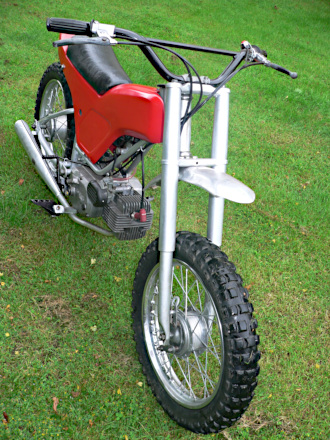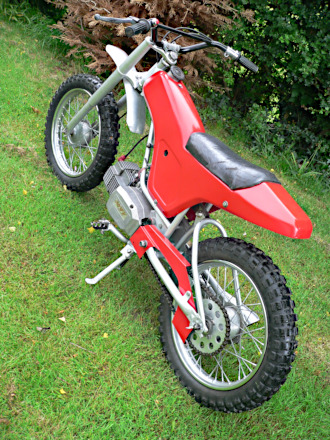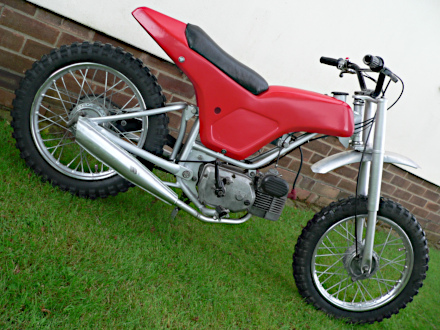Launched locally in East Anglia on 1st October 1974 with a RRP of £99.36p, the SIM-50 became the first British produced Junior mini-bike and established a footprint for new sales opportunities in mini-motor cycles for children.
In July 1975, various Norton–Villiers–Triumph prototype motor cycle and moped models, designed by Bob Trigg, were presented at a London press conference by Managing Director Dennis Poore and Shadow Industry Secretary Michael Heseltine MP. The ‘Tubone’ frame assemblies of the mopeds were contracted to Verlicchi in Italy as an established and specialised trade frame maker who had built chassis and supplied proprietary parts for many major moped, motor cycle and automotive manufacturers over the years, though never produced any complete vehicle under its own branding.
As the first Easy Rider ER1 and ER2 step-through automatic models were introduced in March 1976, most of the parts were clearly factored components from Italy: Morini Franco engines, Grimeca hubs laced into Radaelli rims; being supplied with fitted Pirelli tyres rather suggested the wheels came complete. The telescopic front forks were typical Italian market, as were the rear suspension units, saddle, the Domino controls, CEV headlamp, IKJ switchgear, and Brevetti exhaust & silencer.

By May 1976, the Mk2 SIM-50 was priced up to £132.26p.
On 15th September 1976 the RRP of an ER1 Easy Rider moped was listed at £155 (inc vat), and further ER2L sports, ER4L, and ER4TL sports models were added to the range in November 1976.
After a few years with no sales competition for the commercially produced Woodhouse Cornish SIM-50, now into its Mk3 version, it was joined in 1978 by other makes of children’s bikes as Puch introduced its Magnum X, and NVT brought out its Ranger, priced at £269 (exc vat).
The Ranger seemed appreciably more expensive than the Easy Rider ER1 moped!

The Morini Franco motor is basically the same spec as the NVT ER1 Easy Rider, though with a kick-start mechanism rather than pedals. Specification is 40.4mm bore × 39mm stroke, and quoted at 7.5:1 compression ratio. While the Easy Rider mopeds were rated at 2.2bhp and standardly had a 12mm SHA 12/14 Dell’orto, the Ranger instead had a 9mm SHA 9/14 to restrict its power, and though we don’t know its rating, that would be expected to drop around 0.5bhp due to the smaller carburettor.
The semi-tubone frame is very probably another Verlicchi fabrication, and is fitted with a stylish fibreglass bodyshell, simple lightweight grease forks, employing the same Grimeca hubs fitted to the Easy Rider mopeds, but laced into 14-inch rims and fitted with rugged looking ChengShin 2.75–14 knobbly tyres.
The bike feels quite light compared with a typical moped, so just for reference we roll it across the weighbridge (bathroom scales), and read 3st rear & 2st 10lb front = 80lb/36kg.
Surprisingly, the Ranger has a frame number, this one is J705, stamped down the left-hand side front mono-shock mounting plate. Another example has been advised as being over J1200, so they obviously made and sold a surprising number of these machines. Colour schemes were given as Red & Silver and Blue & Silver, though our machine seemed to have originally been coloured with an orange gel coat, so presumably there were other options. The mag-set was fitted with a lighting generator coil even though no lights or horn were fitted. This is likely because the motors were purchased as complete standard units.
The SIM (Speedway In Miniature) was a very different machine from its newer and more commercially produced market competitors. The SIM-50 was a physically smaller and rigid framed machine designed for 5–10 year olds, though quite capable of being ridden by an adult due to its design and construction.

Rather than suggesting an age range, the Puch Magnum was a swing-arm twin-shock frame rated for a weight limit of 98lb (7st) and, though the rear suspension compressed to coil bound with an adult seated, the bike could still be ridden.
Though the Ranger seat height at 26 inches is lower than a typical moped, it may seem as if you could ride one of these NVT mini-bikes, but it’s quoted for riders 6–12 years age, and has mono-shock rear suspension which compresses right down until the rear frame bottoms out on the tyre and prevents the wheel from even turning, so would it seem there’s no way the Ranger can be ridden by adult—but we need to do a road test…
We scheme a plan to get over our weight problem that prevents an adult from being able to ride one of these machines, by fabricating a solid strut to replace the mono shock spring unit, so making the rear frame rigid. Ha, fooled you young master Ranger!

So, now we can ride it, we turn on the fuel tap at the bottom left of the body panel, click on the choke at the carburettor and, within a couple of kicks, the motor fires up and sits ticking over on the stand, tidy as you like. Within a couple of minutes the tickover starts to drop a little, so we open the throttle wide to release the choke latch, as the bike starts to tug enthusiastically on its automatic clutch. Mounting up, we scoot down the drive and into the lane to clear the motor, and Ranger is already pulling cleanly to demonstrate its willingness to perform. Acceleration is pretty good, though unsurprising considering this bike is obviously very low geared, so much so that the bike is over-revving so quickly that we instantly become concerned that we could blow up this newly rebuilt engine. Ranger revs out so quickly that we don’t think it’d be wise to even try pacing the top speed, for fear the freshly restored motor might be over-revved and dead before our pacer even got a reading.
So how low geared is it?
Ranger has a 40-tooth rear sprocket, while the Easy Rider has 30 teeth. That’s a 25% drive ratio reduction.
Ranger has 14-inch wheels with 2.75-inch tyres for a 19-inch overall diameter, while Easy Rider has 17-inch wheels with 2.25-inch tyres for a 21-inch diameter = 9.5% drive ratio reduction.
Assuming that an NVT Easy Rider ER1 single-speed auto might normally be expected to achieve, say, 32mph—a reduction of 34.5% in drive ratio suggests the machine would be geared to 21mph at the same revs; that seems fairly close to the 18mph quoted in Ranger advertising literature of the time. Perhaps they were trying to suggest not to over-rev it … but if you have no speedo, how would a child even know? The mild performance figures were only presented for the comfort of adult buyers.

Instead of the 12mm Dell’orto, which was ordinarily fitted on Easy Rider models, a smaller 9mm Dell’orto carb was fitted to the Ranger, presumably to limit the motor power, but it seems to have a negligible effect due to the reduced gearing, since it still revs out very easily.
Pootling along at around 15mph doesn’t really give much to comment on regarding handling, but the coarse block treads on the knobbly tyres gave a gnarled ride on tarmac, though the Easy Rider hubs in the smaller wheels expectedly delivered excellent braking at the Ranger’s reduced speed.
If the forks on this Ranger appear a bit ‘chunkier’ than the usual Ranger forks, that’s because this bike is fitted with Easy Rider forks since the originals had bent stanchions and broken springs. Easy Rider forks are the same length, offer heavier duty stanchions and springs, and fit straight in.
Out of the three 1970s’ UK main-market 50cc Junior motor cycles we’ve produced features on, the Puch Magnum-X was clearly fastest all round with its 3.5 bhp motor, while the SIM offered similar speed at less revs than Ranger, though the NVT demonstrated faster acceleration. SIM’s Anker–Laura reed-valve engine offered useful torque at lower revs, and its Anker–Laura M-48 would probably prove more durable than the over-revved Morini Franco MO1 in the long run.
All NVT branded models technically ceased in May 1978 as the bankrupt Norton–Villiers–Triumph Group fell into liquidation. NVT Easy Rider models continued to be built from parts in receivership until selling out of stock between February & April 1979. The Puch Magnum was priced at £277 in 1979.

This however was not the end, as ER1 and ER2 moped models resumed under BSA branding from April 1979.
The NVT Ranger also returned, re-branded and re-titled as the BSA Junior from August 1979, and using the same piston-ported Morini Franco MO1 engine as the NVT Ranger.
The ‘pedal’ Easy Rider was further joined by an ER1MK kickstart version in October 1980, which used the same kickstart motor as the BSA Junior. The two-speed ‘pedal’ ER2 was discontinued in March 1981.
During the early 1980s, a reed-valve variant of the MO1 engine was introduced to the Easy Rider ER1M/MK and BSA Junior, for which the advertising claimed ‘gives the Junior powerful acceleration, yet maximum speed of no more than 25mph’.
So yes, the reed-valve would improve acceleration, and just by mentioning ‘25mph’ was maybe now ‘suggesting’ the reed-valve motor ‘might’ be capable of going faster than the earlier piston-ported motor quoted at 18mph, but in reality could only get to over-revving quicker, and unless the low gearing was raised, still wouldn’t be likely to reach any faster speed than 21mph without over-revving and prematurely expiring.
It still had the same 40-tooth rear sprocket, and same size wheels, so unless the gearing had been raised by fitting a larger front sprocket … form your own opinion …
ER1M and MK models continued into 1986, when the ER1M pedal version concluded in May 1986.
The ER1MK discontinued in December 1987, along with the only other remaining BSA branded GT50 model.
The final BSA Junior variant was the JTX, around its last year in 1986, with cast wheels, a different bodyshell moulding, and up & over exhaust system.

